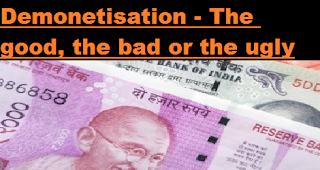Demonetisation - The good, the bad or the ugly: PMGKDS
Demonetisation - The good, the bad or the ugly
Depending upon which side of the political fence one sits, the time one has spent standing in the bank queues and the inconvenience that ensued, demonetisation could mean any of the above for you. But what remains undeniable is that it comes as an inflection point in India’s economic history. While the days following the demonetisation were marked by intense debate, the bulk of it was on the manner in which it was executed and the level of preparation in place to deal with the aftermath of November 8, 2016.
Cut to September 2016, where with the Income Disclosure Scheme, the government offered tax evaders a choice between a carrot and a stick, a final opportunity to come clean as harsher steps were on the anvil and perhaps expectedly so.
[post_ads]
The turn of events on November 8 did surprise not just the citizens but also large sections of the regulatory machinery and the ruling government. This is evidenced by the fact that there were circulars galore that came out almost on a daily/weekly basis during the period following November 8 offering up regular course corrective changes in guidelines and policy. A quick memory jog on the key developments that transpired post November 8.
Nearly 68 lakh non-filers of Income Tax Returns who carried out high value transactions were identified through the Non-filers Monitoring System (NMS).
The government cautioned against any attempts to revise income tax returns as a consequence of the demonetisation of high value currency.
The thresholds for quoting of Permanent Account Number (PAN) while depositing cash in banks and post offices were made stricter.
Threshold limits for reporting of transactions during period from November 9 to December 30 by banks and post offices were made more rigorous (Rs 12.50 lakh for current account, Rs 2.50 lakh for others).
The Taxation Laws (Second Amendment) Act, 2016 was enacted. Under this legislation, the government introduced the ‘Pradhan Mantri Garib Kalyan Deposit Scheme’, 2016 (PMGKDS). A declaration under this scheme would result in taxation at 50 percent (including surcharge and penalty). In addition, 25 percent of the undisclosed income shall remain as a deposit with the government for a period of four years.
[post_ads_2]
The naysayers had been predicting doom and gloom, but, the early signs appear to be encouraging with tax collections showing a healthy rise and in some case an unprecedented increase, which is a morale booster for the government as it prepares to deliver what most feel would be a ’populous’ budget.






Post a Comment